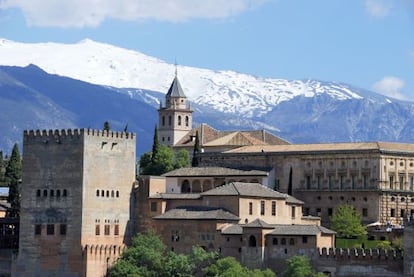The unmistakable sights and smells of Granada's Alhambra fortress
The monument's treasures lie in its poetic language of the senses

There are different ways of approaching the spirit of the Alhambra and the Generalife. But to get a real feel for their essence, especially now that the 1,000th anniversary of the Kingdom of Granada is being observed, visitors must follow the course of the water, and the water begins at the dam of the Sultan, six winding kilometers uphill in the narrow Darro valley, at the foot of the Alfaguara mountain range.
There, at an altitude of around 840 meters, the Nasrid prince built a small reservoir to collect the river water and serve Sabika Hill, where the "alcazaba," or citadel, would be built beginning in 1238. Over the next two centuries, builders would erect the fabulous palaces of the Nasrids - the last Muslim dynasty to rule in Spain - that continue to amaze travelers from all over the world.
First came the palace of Comares, with its Alberca and Arrayanes courtyards, built under Youssuf I (1333-1354); later came the exquisite garden palace, built in two tiers around the recently restored Court of the Lions, which is the golden heart of the entire fortress. It is enough to stand in the middle of it and hear the murmur of its 11 fountains to understand that water is the key element here. It can also be discovered with one's eyes closed, through the smell of the aromatic herbs and the agapanthus plants inside the Acequia courtyard, as well as the sound of the water crossing the Ciprés de la Sultana courtyard before it reaches the Generalife, the emirs' summer palace.
Another rite of initiation - reserved for those who come early to the Alhambra - consists of watching the antics of a grey heron that has been nesting here for several winters, and which fishes for carp in the mornings in a water tank at Partal palace, one of the oldest buildings on the premises.
The Alhambra would not exist without its fountains, its water pools, its taps, its cisterns, its piles and its ponds.
The gardener, Cristóbal Romero, says - and he is right - that the Alhambra would not exist without its fountains, its water pools, its taps, its cisterns, its piles and its ponds, and that is why the first jewel in the crown of this Unesco Heritage Site is the Acequia del Sultán, or the Sultan's irrigation channel, which used to bring water down from the mountain in a 6,100-meter-long feat of engineering. It overcame natural obstacles thanks to underground sections that run part of the route, as well as tunnels, which were bored through the hard rock. There was also a large tank, which was protected by a tower and featured a waterwheel, which raised the liquid so that it would reach the higher gardens of the Generalife. The Acequia Real forked into two branches before it got as far as the Alhambra to serve outlying areas, before coming together once more to enter the Alhambra proper through an aqueduct that crossed the water tower, where Félix Garrido now stands.
Garrido has been working at the Alhambra for 25 of his 56 years. For a long time it was his job to clean the old Arab irrigation channel, which is currently not used and in a state of almost complete disrepair, he explains. One of the top priorities today, according to the president of the Board of the Alhambra, María del Mar Villafranca, is to restore this element and the old hydraulic system, just like with the medieval vegetable patches, which were brought back several years ago as part of the heritage of the complex.
Félix Garrido is now in charge of these vegetable gardens, which tourists can come and visit. Its four terraces grow artichokes, beans, eggplants, carrots, spinach and cauliflower. There are also fruit trees producing pomegranates, hazelnuts, prunes, pears, persimmon, lemons and figs. There is no commercial purpose to this gardening." The crops are shared out fairly: staff and locals take away the vegetables and the persimmon, while the squirrels take care of the nuts," he explains.
The water and the orchards, but also the language of the senses and the poetry, are all part of the treasures of the Alhambra, just like its domes of impossible-looking honeycomb work, its geometric tiles, the beautiful simplicity of its palace towers and the carpentry in the ceiling of the Comares hall.
Jesús Bermúdez was born in the Alhambra when it was just another neighborhood in Granada. His father was the founder of the Archeology Museum and he is technical adviser in archeology for the Board of the Alhambra as well as author of the official guide to the premises. Bermúdez agrees that there are "intangible" elements that contribute to the magic of the Alhambra, like its architecture and its perfumed gardens. One of these elements is Jorge Luis Borges' poem to the Alhambra, written in 1976 after visiting it when he was already blind (he had been here as a 20-year-old and had never forgotten it).
The Granada writer Francisco José Ayala says he remembers a meeting with Borges in Buenos Aires in which the author of The Aleph managed to convey "the brightness of the Alhambra" with his "remaining senses."
Tu suscripción se está usando en otro dispositivo
¿Quieres añadir otro usuario a tu suscripción?
Si continúas leyendo en este dispositivo, no se podrá leer en el otro.
FlechaTu suscripción se está usando en otro dispositivo y solo puedes acceder a EL PAÍS desde un dispositivo a la vez.
Si quieres compartir tu cuenta, cambia tu suscripción a la modalidad Premium, así podrás añadir otro usuario. Cada uno accederá con su propia cuenta de email, lo que os permitirá personalizar vuestra experiencia en EL PAÍS.
En el caso de no saber quién está usando tu cuenta, te recomendamos cambiar tu contraseña aquí.
Si decides continuar compartiendo tu cuenta, este mensaje se mostrará en tu dispositivo y en el de la otra persona que está usando tu cuenta de forma indefinida, afectando a tu experiencia de lectura. Puedes consultar aquí los términos y condiciones de la suscripción digital.







































